An unfortunate reality is that police officer shooting accuracy is nothing like what Hollywood depicts.
According to a 2008 RAND Corporation study evaluating the New York Police Department’s firearm training and performance, between 1998 and 2006, the department’s average hit rate during gunfights* was 18 percent. When suspects did not return fire, officer accuracy increased dramatically… to 30%. What makes that particularly unfortunate is the reality that all fired bullets have to go somewhere. Inaccurate shooting has innocent victims.
Statistics from the Metro-Dade Police Department from 1988-1994 published in a Police Policy Studies Council report indicate that officers had fired approximately 1,300 rounds at suspects during that period, missing more than 1,100 times. Their hit rate was a hair over 15%, most of those shots from very close distance.
For the Los Angeles Police Department, in 2016 the total number of rounds fired compared to total number of rounds which struck their intended targets resulted in a hit ratio of 48%. This was a 10 percentage point increase compared to 38% in 2015. Context, however, is important: the LAPD’s 2012 through 2015 aggregate hit ratio was just 28%.
The devil is in the details whenever you are examining data. Here are two examples relating to officer accuracy figures:
Example #1: The statistics above don’t account for lighting conditions. Indeed, there are some indications that officer accuracy is significantly higher in adequate lighting.
Example #2: The number of officers present has an enormous correlation with shooting accuracy. Data from Los Angeles County (sourced between 1998 – 2002) indicate that officer accuracy drops from ~50% when one officer is present to an astonishing low of 9% when more than two officers are involved. Meanwhile, the average number of shots fired per officer was 3.59 when a single officer was involved, and increased to 6.48 when more than two officers were involved!
Michael D. White of the John Jay College of Criminal Justice examined what he called “the well-documented inaccuracy of police officers who use deadly force” in a 2006 paper titled “Hitting the Target (Or Not): Comparing Characteristics of Fatal, Injurious, and Noninjurious Police Shootings.”
His conclusion:
“A number of factors emerge as predictors of shooting accuracy including distance, suspect actions, and officer approach and preparedness. Alternatively, a number of seemingly important factors appear unrelated to shooting accuracy including lighting conditions, use of cover, and gun type.”
So… it’s complicated.
Another surprising non-correlation? A 1988 -1994 dataset from Metro-Dade Police showed no significant correlation between officer range scores and officer accuracy in the field.
More recent data indicate no significant change. A 2018 study of the Dallas Police Department published by the Force Science Institute found that the department’s overall hit rate was in line with all of the other research. Researchers analyzed 149 real-life OIS incidents over a 15-year period. In nearly half of these encounters, officers firing at a single suspect missed the target entirely. In the 134 cases where researchers could establish the number of shots fired, they calculated the hit rate at 35 percent.
The authors of that research caution their reader that the “generalizability of findings†from a single department “may be limited” and urge that future research “investigate shooting accuracy in a more comprehensive model†to confirm that their findings are representative of law enforcement beyond Dallas Police Department.
Unfortunately, it appears to be.
This video provides a rare direct view of the (in)accuracy described above.
SOURCES
Rostker, Bernard D., Lawrence M. Hanser, William M. Hix, Carl Jensen, Andrew R. Morral, Greg Ridgeway, and Terry L. Schell, Evaluation of the New York City Police Department Firearm Training and Firearm-Discharge Review Process. Santa Monica, CA: RAND Corporation, 2008. https://www.rand.org/pubs/monographs/MG717.html.
Los Angeles Police Department, “Use of Force: 2016”
White, M. D. (2006). Hitting the Target (or Not): Comparing Characteristics of Fatal, Injurious, and Noninjurious Police Shootings. Police Quarterly, 9(3), 303–330.
Aveni, T.J. (2003). Officer-Involved Shootings: What We Didn’t Know Has Hurt Us. The Police Policy Studies Council
https://www.politifact.com/truth-o-meter/statements/2018/may/25/shannon-watts/do-more-7-10-police-bullets-miss-their-mark-gun-co/
*A gunfight was defined as a confrontation where the bad guy has a gun.
** (Disclaimer: This video content is intended for educational and informational purposes only) **

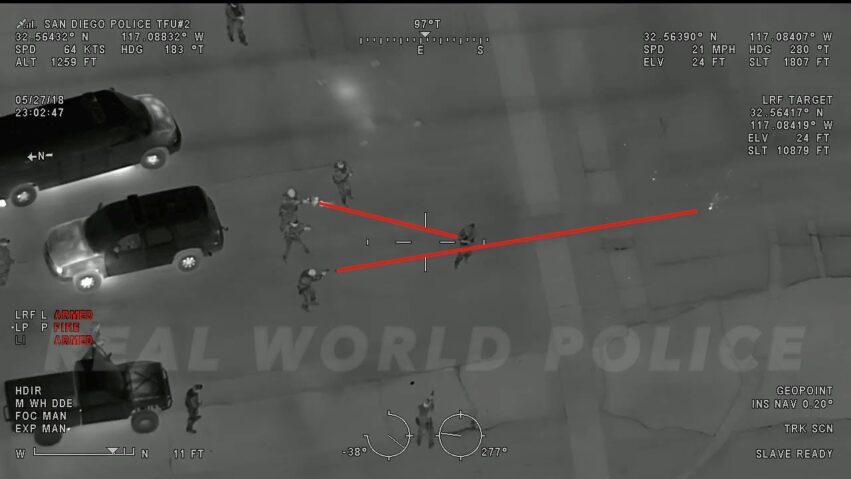
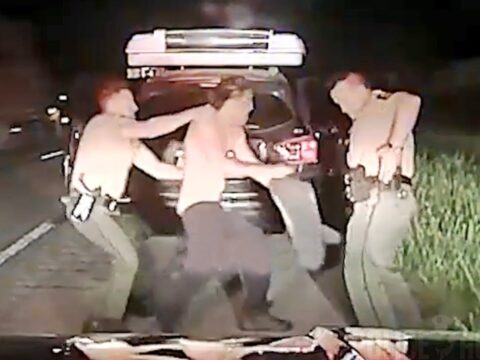
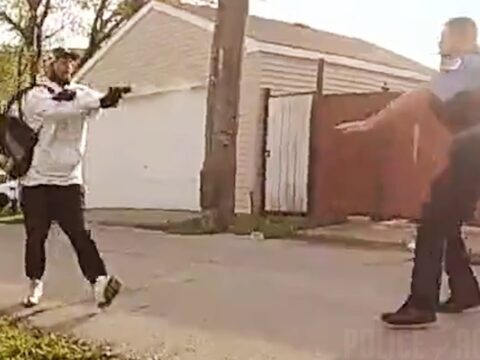
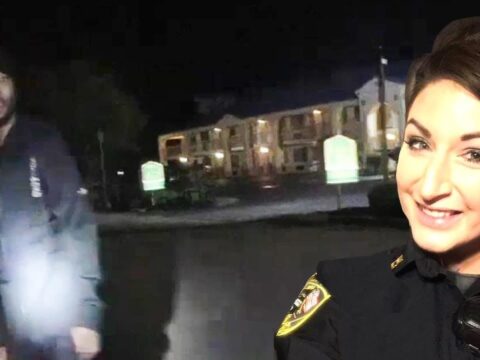




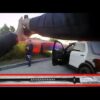

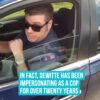





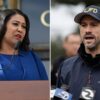




As always, there is much more information (including citations to sources) in the video description.
It really seems like less lethal rounds should be used in situations like this where a guy is running around with a knife and officers already have their guns drawn and pointed at them. If you're the only person there, I can understand wanting to totally disable the assailant but there were dozens of officers here. I just feel like there should be other options to confront these situations. I'd imagine rubber bullets would have brought this situation to an end without the guy dying.
You always try to calibrate direction by moving object
Looks like Star Wars
Holy shit! These guys are using phasers!
THE FUTURE IS HERE! THE FUTURE IS HERE!
Bruh officer at the bottom got shitty aim(i know its an intense situation not saying he bad or anything)
The more officers involved, the more they have to worry about crossfire. Watch the four officers bunched up in the video, and how they jockey to avoid each other.
officer third from top of screen cheated.
he had aim-bot
WRONG a few of the bullets go THRU him , then they hit the ground
It looks like a star wars scene
ОСТОРОЖÐО: в ролике ÑодержитÑÑ Ð½ÐµÑ†ÐµÐ½Ð·ÑƒÑ€Ð½Ð°Ñ Ð»ÐµÐºÑика. ПожалуйÑта, либо запикивайте её, либо помечайте ролик, например, 18+ в названии.
@Real World Police. Here is another issue that NO ONE seems to be taking into consideration. Not all shots fired at suspects are meant to hit their target. If there is a good background, and no citizens are in danger, suppressive fire can be used to keep a suspect down in order for officers to get to cover. Suppressive fire rounds are counted in the amount of round shots and missed, but they were not necessarily intended to hit their target. Its not used often, but it is a valid way to keep a suspect down so officers can find a better tactical position or get to cover. It should NEVER be used if you don't have a good background to stop the bullets where they could injure an innocent. There are a lot of agencies that have policies that prohibit suppressive fire, but in the real world it happens and they can never prove that's what you were doing.
Lol, bottom right "SLAVE READY" whats that supposed to mean?
Amazing how quickly they can go from shooting someone to saving their life (or at least trying to)
Myth? Its just like in movies, cops and bad guys never land a freaking shot lmao
hit behind the target does not neccesary have to be miss. It could be penetration shot.
The only accuracy I know is when I’m holding an angle and get killed the moment the enemy peeks
I suppose this is why officers are real careful about crossfire, then?
slave ready
so you're saying there's a chance?
This is cool i appreciate the time and effort put into this video and the visualizations
Me and the boys playing Dust II
It was a bit of overkill in my opinion, I mean, they kept firing after he dropped to the ground. Also, couldn’t they have used a taser, any of them?
why does this look like a game.
can some1 edit this by adding lightsaber and with sound effects on the dead guy?
such a shitty police work
One of the sad truths is that accuracy, especially with handguns, is not something that can be taught. You can refine range accuracy, yes, but real-world precision in high-stress scenarios relies far more on other innate factors like body control, clear-headedness, and quick decision-making ability than it does firearm handling skills. It's been demonstrated over and over that the way we train law enforcement in firearms makes no discernible difference in their real-world effectiveness. The students that perform very well in live-fire, high-stress simulations will perform that way in real life, those that perform poorly in them will continue to perform poorly in real-life situations. The problem with most PDs is a culture and budget that favors many low IQ, low performing applicants due to a need to keep costs down. Hell, my PD turns away kids because they're too smart, too good in tests. Too many bright applicants increase competition and costs between departments. The US police system has slowly allowed itself to become a refuge for thugs and goons, not officers.
Pta 15 tombos para un weon no sé si con problemas mentales o no, pero estos csmres son de esos jugadores de consola que ya derribaron al enemigo pero le siguen disparando. xd
i'm guessing the bald cop has the most time at the range, or the most experience considering he didnt miss once.
Человека заÑтрелили, а вы точноÑÑ‚ÑŒ обÑуждаете безмозглые…
I hate when they handcuff them even after shooting them 10 times like…..the man obviously is gonna die of not already dead let him die with his hands free.
Me: it sucks seeing someone shot up like this (even tho it’s justified)
Also me: yo can you do more
WTF ??? 21 bullets for a guy with a knife. USA is fucked up.
why does bottom right corner say slave ready wtf
Also as far as I remember in military it usually takes one to two mags to land a hit on a target more then 500 meters away
next time call your hits. i always shoot till i see someone raise their hand and call their hit smh
Fact is, that when you never shot someone to death in your life you will probably try to miss to spare human life, I think i have heard this from some veteran, or so….
If any one was wondering, their overall accuracy was 50%
Murica… fuck yeah, also why did they keep shooting when he was already falling? that would get you jail time in Europe anywhere…. did you deliberately miss the one frame @2:05? second shooter from the bottom did fire after he was already on the floor
This was good, but some of the shots you see make the guy getting shot visibly recoil from a hit, and it is displayed as a miss. Other than that, Great breakdown!
40%
So you've got enough money for 50+ cops, all those police and emergency vehicles, a helicopter with advanced stabilized thermal optics and a budget for deep incident analysis… and you still had to kill a mentally ill person cause he had a knife? How about spend some money on less-than-lethal weaponry and oh, I don't know… mental health maybe? LOL! 'Merica!
the video description is an essay, I bet it can pass my English class with it.
I believe this is arma 3 right?
dude on the right needs to get kicked off the force lmfao negative kd and accuracy having ass
Thats how they shoot me in GTA… just like in real life 🤔